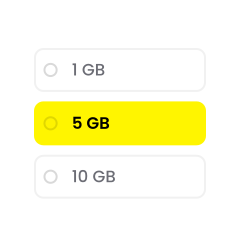- Empty cart.
- Continue Shopping
Did you know your phone probably doesn’t need a SIM card? An eSIM can save money and help you avoid paying high roaming fees. We’ll explain what eSIMs are and why you should use them whenever you travel.

An eSIM does everything a traditional SIM card can, such as connecting you to a phone network and identifying you to the network provider. The eSIM chip and the software required for an eSIM to work come preinstalled with almost all modern smartphones now, as well as other types of devices. So, how do eSIMs work? If you want to start using a SIM card, you have to open the tray, take out the old SIM, and put in the new one. With eSIMs, you avoid all of that because your eSIM can be programmed remotely. You only have to turn on your phone and activate the eSIM.
Before you start your journey, make sure to check, whether your device is compatible with eSIM. Chances are it does, but you should know for sure. Then, follow these steps to get a Saily eSIM:

Select the country of your future destination and choose your data plan.

Set up the eSIM on your device by following the instructions.

Activate your eSIM before leaving — it requires an internet connection.

An eSIM enables you to connect to a local carrier and avoid exorbitant roaming fees.

If you’re traveling to Japan for a week, you can get a 7-day Japanese data plan and save money.

If a device doesn’t require a physical SIM card slot, it can be made smaller.

Without a removable SIM card, you can prevent several cybersecurity risks that involve the unauthorized use of SIM cards.

An eSIM supports multiple SIM profiles, so you can switch between carriers without buying a dual SIM phone or swapping physical SIM cards.


Up to two
Up to two (if your device supports it)

Multiple

Deactivate the profile
Remove the SIM card

Remote: set it up on your device yourself
Manual: buy a card from a carrier and insert it

Newer devices
All old and most new devices

Affordable — easy to get data plans in different countries
Deal with expensive roaming or buy a new local SIM card

Stores multiple offers
Limited profile switching

eSim up to two
Sim Up to two (if your device supports it)

eSim Multiple
Sim Up to two (if your device supports it)

eSim Deactivate the profile
Sim Remove the SIM card

eSim Remote: set it up on your device yourself
Sim Manual: buy a card from a carrier and insert it

eSim Newer devices
Sim All old and most new devices

eSim Affordable — easy to get data plans in different countries
Sim Deal with expensive roaming or buy a new local SIM card

eSim Stores multiple offers
Sim Limited profile switching
eSIMs is a relatively new technology. The first eSIM-supporting smartphone was released in 2016. So, while eSIM popularity is growing, the infrastructure is not yet developed to support eSIM technology fully.
User awareness is another factor. People use eSIMs with wearable and IoT devices, but few know that they probably don’t need a traditional SIM card.
There are a few drawbacks to physical SIM cards. They can be damaged or lost, especially if you need to swap out cards often. SIM cards can also be stolen. eSIMs, on the other hand, are embedded into your device. You can’t damage, lose, or have it stolen unless your phone is damaged or stolen too.
While eSIMs support multiple profiles and can give you a phone number, whether or not it does depends on your eSIM plan.
Yes, an eSIM can work without the internet, such as make calls or send messages. But it depends on your eSIM plan and your provider. Also, just like a physical SIM card, you have to activate the eSIM first.
Battery drain is not an issue with eSIMs, at least not more than with physical SIM cards. If your device has been using more battery power lately, it’s likely caused by an app on your phone.
Yes, you can convert an eSIM back to a physical SIM but you may need to go to your network provider to get a new SIM card.